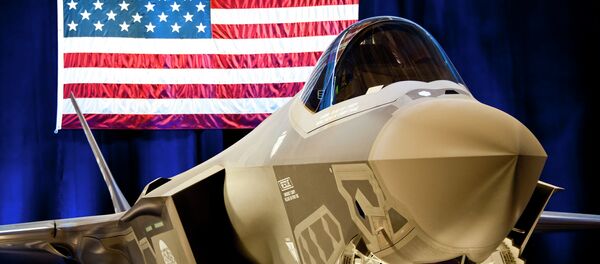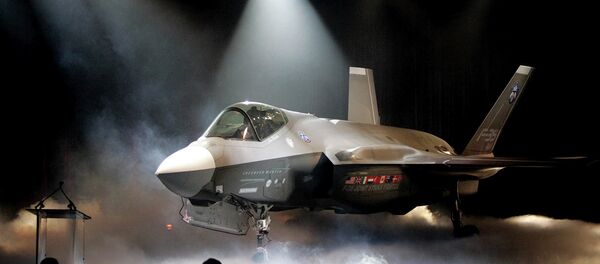The stealth fighter is supposed to come equipped with sophisticated software systems to do everything from detect incoming threats to spotting maintenance problems on board to communicating it all to ground control.
Earlier in the year it was reported that the sensors were producing a high rate of false alarms. Now the problem is with the maintenance assessment system that was supposed to radically simplify the upkeep process for the jets.
False alarms are once again the problem, as maintainers at Eglin Air Force Base, Fla. say that 80% of the issues reported by ALIS are "false positives." A house armed services subcommittee that visited the base also heard that the systems were sluggish, to the point of slowing down the maintenance they were supposed to be speeding up.
"When we asked them how many false positives, I thought it would be a high number because it is a new system," Rep. Mike Turner (R-Ohio) said during a hearing Tuesday about the program's $10 million funding request the next year. "But when they said 80, I was taken aback."
— Giovanni de Briganti (@JoedeBrig) April 15, 2015
Lt. Gen. Christopher Bogdan, the executive officer in charge of the F-35 program, said that the ALIS program, which currently comprises 5 million lines of code — "has a long way to go." and that ALIS was treated like an afterthought for too much for the fighter's development.
The problems exist in all three of the F-35 variants, designed for the Air Force, Marines and Navy.
"The issue of false positives is very real," said the assistant secretary of the Navy for research, Sean Stackley. "The concerns with regards to the reliability, responsiveness, the timeliness of ALIS informing the war fighter is at the top of our priority list."
The sheer size of the ALIS system — on computer racks weighing around 1,000 pounds — has also made it too large for use in testing on carriers and a smaller version is supposed to be ready by July.
In addition to the false positives and false alarms, there were recent problems reported with the systems' ability to fuse data together when four fighters were in the air at one, forcing the Marine corps to modify operations so that four jets would fly as two teams of two jets, instead of one integrated team.
Just recently, another software related error was announced, which means that the fighter won't be able to fire its primary guns until 2019. It will also not have the necessary software to operate one of its precision guided bombs until 2022.
Meanwhile the aircraft carrier specifically optimized to accommodate the F-35 will itself need 40 additional weeks of upgrades to handle the plane. The USS America - which cost $6.8 billion to begin with — will have to spend almost a year in dry dock being adapted to the fighter is was designed to be adapted to.
"Acquisition Malpractice" And Other Nicknames for the F-35
The program has already nearly doubled its original budget to $400 billion dollars in spending — making it the most expensive plane in history. And that doesn't take into account the $5 billion or so the military has spent to extend the existing fleets this plane was supposed to replace or the $650 billion or so in maintenance costs the Government Accountability Office has estimated will be necessary, which would bring the total cost to well over $1 trillion dollars over the next few decades.
— Straus Reform (@StrausReform) March 12, 2015
Many attribute the difficulties of the program with the overzealous demands from all branches of the military to incorporate features to suit their particular needs all in one plane, with some calling it the Flying Swiss Army Knife. The F-35 is supposed to be a bomber, a fighter, and capable of performing ground support, but some of those capabilities have contradictory needs. Add to it a load of highly complex computer systems and by trying to please everyone, it may end up performing for no one.
— Angry Staff Officer (@pptsapper) April 8, 2015
In 2008 the RAND corporation — a think tank that works closely with the US military — reported on a series of war simulations involving the F-35 and their analysis was leaked to the press with its pessimistic conclusions. "Inferior acceleration, inferior climb [rate], inferior sustained turn capability," the analysts wrote. "Also has lower top speed. Can’t turn, can’t climb, can’t run."
There's also been a lot of concern over the possibility that this supposed state-of-the-art stealth fighter — supposedly designed to evade detection through its size and special coatings — isn't actually very stealthy. Reports in 2014 indicated that the F-35 might actually be vulnerable to Chinese and Russian advances in radar technology.
The planes were also rushed into production before design was even completed, meaning the military has spent billions of fixing already produced aircraft that were faulty.
"This will make a headline if I say it, but I'm going to say it anyway," Frank Kendall, a top Pentagon official, said in 2012. "Putting the F-35 into production years before the first test flight was acquisition malpractice. It should not have been done."





